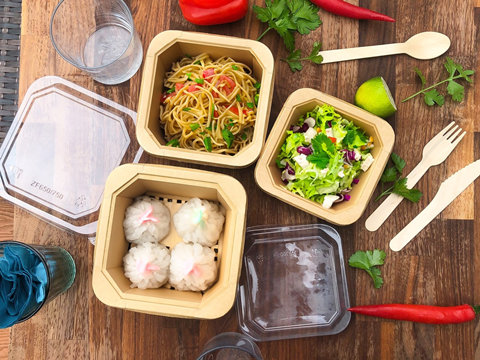
In a reported ‘industry first’, H-Pack has developed standalone, premium containers made of kraft paper with accompanying PET lids, gearing them towards high-end hot and cold foods.
The pack itself is distinguished by its shape, H-Pack explains. Its internal corners are straightened to create a subtle octagonal effect and, in the company’s view, signify both quality and attention to detail.
Meanwhile, the transparent PET lids are implemented to reveal the food inside the pack, enabling consumers to view the product before they buy. It is also set to ‘complement the quality of the containers’.
As an addition to H-Pack’s Hot n’ Fresh range, it is anticipated that the packs will be utilized by higher-end players in the food-to-go market, such as delis, farm shops, farmers’ markets, and specialist, upmarket food retail outlets. Containers in sizes ranging between 300ml, 400ml, 650ml, 750ml, and 1,000ml will be available from July.
“The market is saturated with cheaper, less robust, white paper boxes,” says David Martin, head of merchant sales for H-Pack. “Quality is a huge priority for those offering higher-end deli and takeaway options and we want to reach out to these packaging customers.
“Subtle, tasteful food packaging reflects well on the food being sold and helps to sell the product, justifying more expensive prices and complementing the overall offering.
“For H-Pack, it’s great to be able to stand out from the competition with a design that is different and we’re looking forward to taking on the market with these very special kraft containers.”
A similar product line from Eco-Products includes deli containers, clamshells, and salad bowls, each clearly signifying on-pack that the material is compostable via the BPI Certification Mark and green or brown identification elements like tinting and striping. It is hoped that consumers, composters, and the foodservice value chain as a whole will easily be able to gauge the compostability of the products compared to non-compostable packs.
Yangi has designed its own renewable, fibre-based container lid for dry and ambient food products to be compatible with recycling systems worldwide. Produced via dry forming processes, it seeks to reduce environmental footprints and meet growing demand for environmentally conscious food packaging.
If you liked this story, you might also enjoy:
How are the top brands progressing on packaging sustainability?
The ultimate guide to global plastic sustainability regulation












No comments yet